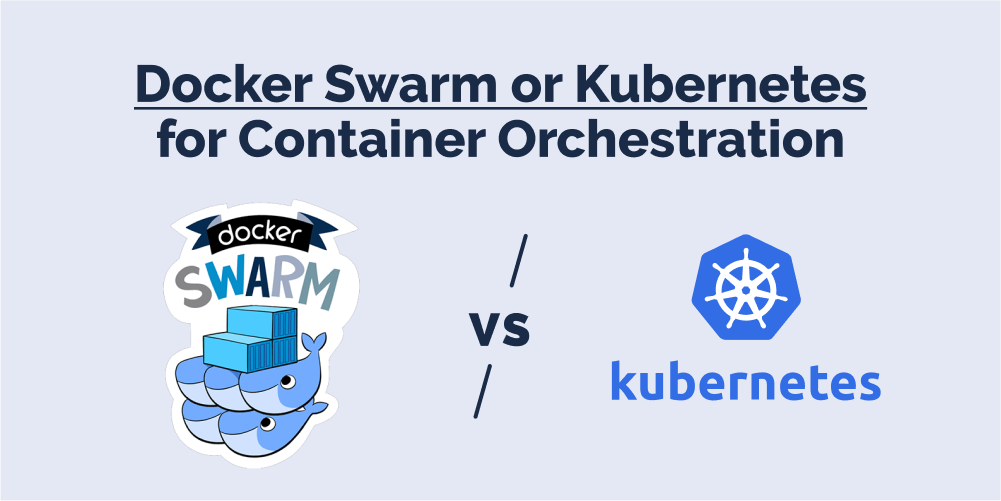Digital Transformation, zBlog
Docker Swarm vs. Kubernetes: Choosing the Right Container Orchestration Solution
trantorindia | Updated: May 2, 2024

Introduction
In the world of modern software development, the use of containers has become ubiquitous. Containers provide a consistent, reliable, and scalable way to package and deploy applications, making them an essential tool in the toolbox of any DevOps or software engineering team. However, as the number of containers and the complexity of your infrastructure grows, managing and orchestrating those containers becomes a critical challenge.
This is where container orchestration solutions come into play where two of the most popular and widely used container orchestration platforms are Docker Swarm vs Kubernetes. Both offer robust solutions for managing and scaling your containerized applications, but they have distinct features, strengths, and weaknesses that make them suitable for different use cases and deployment scenarios.
In this comprehensive blog post, we’ll dive deep into the world of Docker Swarm vs Kubernetes, exploring their key features, comparing their performance and scalability, and helping you determine which one is the best fit for your specific needs.
Understanding Docker Swarm

Docker Swarm is a native container orchestration solution that is built into the Docker engine. It was introduced by Docker Inc. in 2015 as a way to simplify the process of managing and scaling containerized applications.
Key Features of Docker Swarm
- Simplicity: Docker Swarm is designed to be easy to set up and use, with a straightforward command-line interface and intuitive configuration. This makes it a great choice for teams new to container orchestration or limited resources.
- Tight Integration with Docker: Since Docker Swarm is a native feature of the Docker engine, it integrates seamlessly with the Docker ecosystem, including the Docker CLI, Docker Compose, and other Docker tools. This can streamline your development and deployment workflows.
- High Availability: Docker Swarm uses a distributed architecture with multiple manager nodes, ensuring your container orchestration system remains highly available and resilient to failures.
- Load Balancing: Swarm includes built-in load balancing and service discovery, making distributing traffic across your containerized services easy.
- Scaling: Docker Swarm can automatically scale your services up or down based on resource utilization or other custom metrics, ensuring that your application can handle changing workloads.
- Security: Swarm provides secure communication between nodes using TLS, and supports role-based access control (RBAC) for managing permissions.
Limitations of Docker Swarm
- Limited Feature Set: While Docker Swarm is a powerful orchestration solution, it has a more limited feature set compared to Kubernetes. It may not be able to handle the most complex or specialized container management use cases.
- Limited Ecosystem: The Docker Swarm ecosystem is not as extensive as the Kubernetes ecosystem, with fewer third-party tools and integrations available.
- Vendor Lock-in: Since Docker Swarm is tightly integrated with the Docker platform, it may lead to a higher degree of vendor lock-in compared to Kubernetes, which is a more vendor-neutral solution.
Understanding Kubernetes

Kubernetes, also known as K8s, is an open-source container orchestration platform that was originally developed by Google and is now maintained by the Cloud Native Computing Foundation (CNCF). Kubernetes has become the de facto standard for container orchestration, with a vast ecosystem of tools, integrations, and community support.
Key Features of Kubernetes
- Scalability and High Availability: Kubernetes is designed to handle large-scale, complex infrastructure, with the ability to manage thousands of containers across multiple nodes. It also provides high availability through features like self-healing and automatic scaling.
- Flexibility and Extensibility: Kubernetes is highly configurable and extensible, allowing you to customize it to fit your specific needs. It supports a wide range of container runtimes, storage solutions, and networking providers.
- Rich Ecosystem: Kubernetes has a large and thriving community, with a vast ecosystem of third-party tools, integrations, and services that can extend its functionality.
- Declarative Configuration: Kubernetes uses a declarative configuration model, where you define the desired state of your infrastructure, and Kubernetes works to maintain that state.
- Service Discovery and Load Balancing: Kubernetes provides built-in service discovery and load balancing, making it easy to connect and distribute traffic across your containerized services.
- Security and Governance: Kubernetes offers advanced security features, such as role-based access control (RBAC), network policies, and pod security policies, to help you secure your container-based infrastructure.
Limitations of Kubernetes
- Complexity: Kubernetes is a highly complex and feature-rich platform, which can make it more challenging to set up and manage, especially for teams with limited resources or experience.
- Steep Learning Curve: Mastering Kubernetes requires a significant investment of time and effort, as it has a steep learning curve, with a large number of concepts, components, and configurations to understand.
- Resource Intensive: Kubernetes has a relatively high resource footprint, requiring more CPU, memory, and storage compared to simpler orchestration solutions like Docker Swarm.
Docker Swarm vs. Kubernetes: Comparing the Key Differences

Now that we’ve covered the key features and limitations of Docker Swarm vs Kubernetes, let’s dive deeper into the comparison between the two container orchestration platforms.
- Ease of Use and Setup
One of the key differences between Docker Swarm vs Kubernetes is the ease of use and setup. Docker Swarm is generally considered to be the more straightforward and user-friendly option, with a simpler and more intuitive command-line interface and configuration process. Kubernetes, on the other hand, is known for its complexity and steep learning curve. Setting up a Kubernetes cluster can be a daunting task, especially for teams with limited experience in container orchestration. Kubernetes requires a deep understanding of its many components, such as pods, services, and deployments, as well as its declarative configuration model. However, it’s worth noting that the complexity of Kubernetes also allows for greater flexibility and customization, which can be beneficial for more advanced use cases. - Performance and Scalability
When it comes to performance and scalability, Kubernetes generally outperforms Docker Swarm. Kubernetes is designed to handle large-scale, complex infrastructure, with the ability to manage thousands of containers across multiple nodes. It also provides advanced features like automatic scaling, self-healing, and rolling updates, which can help ensure the high availability and reliability of your containerized applications. Docker Swarm, while still a capable orchestration platform, is generally considered to be better suited for smaller, less complex deployments. It may struggle to keep up with the demands of large-scale, high-traffic applications. - Ecosystem and Community
Kubernetes has a significantly larger and more active community compared to Docker Swarm. The Kubernetes ecosystem is vast, with a wide range of third-party tools, integrations, and services available. This allows you to extend the functionality of Kubernetes and integrate it with other components of your infrastructure. In contrast, the Docker Swarm ecosystem is more limited, with fewer third-party tools and integrations available. This can make it more challenging to customize and extend Swarm to fit your specific needs. - Security and Governance
Both Docker Swarm and Kubernetes offer security features, but Kubernetes generally provides more advanced and comprehensive security capabilities. Kubernetes offers features like role-based access control (RBAC), network policies, and pod security policies, which allow you to fine-tune the security of your container-based infrastructure. It also provides better support for security auditing and compliance. Docker Swarm, while still offering security features like TLS encryption and RBAC, has a more limited set of security capabilities compared to Kubernetes. - Vendor Lock-in
One of the potential drawbacks of Docker Swarm is the potential for vendor lock-in. Since Swarm is tightly integrated with the Docker platform, choosing Swarm may increase your reliance on Docker and make it more difficult to migrate to other container orchestration solutions in the future. Kubernetes, on the other hand, is a more vendor-neutral solution, which can make it easier to migrate to other cloud platforms or on-premises infrastructure. This can be an important consideration for organizations that want to maintain flexibility and avoid vendor lock-in.
Choosing the Right Container Orchestration Solution

When choosing between Docker Swarm vs Kubernetes, there is no one-size-fits-all solution. The best choice will depend on your specific needs, resources, and the complexity of your infrastructure.
Here are some general guidelines to help you decide:
Use Docker Swarm if:
- You have a small to medium-sized infrastructure with relatively simple container management requirements.
- You have limited resources or a team with limited experience in container orchestration.
- You’re already heavily invested in the Docker ecosystem and want to leverage the tight integration between Docker and Swarm.
Use Kubernetes if:
- You have a large, complex infrastructure with high-traffic, mission-critical applications.
- You require advanced features like automated scaling, self-healing, and rolling updates.
- You want to take advantage of the vast Kubernetes ecosystem and community.
- You prioritize flexibility, extensibility, and avoiding vendor lock-in.
It’s important to note that the choice between Docker Swarm and Kubernetes is not necessarily a binary one. In some cases, you may be able to use a combination of both, with Swarm handling the simpler, more straightforward container management tasks, and Kubernetes taking on the more complex, high-scale workloads.
Trantor Can Help You Decide
Trantor specializes in helping organizations navigate the complex world of container orchestration and cloud-native technologies. With a team of experienced DevOps consultants and cloud architects, Trantor can help you assess your specific needs, evaluate the pros and cons of Docker Swarm vs Kubernetes, and recommend the best solution for your organization. Trantor’s services include:
- Consulting and advisory services to help you understand your container orchestration requirements and choose the right solution.
- Deployment and configuration support to set up your chosen container orchestration platform, whether it’s Docker Swarm, Kubernetes, or a hybrid approach.
- Ongoing management and support to ensure your container-based infrastructure remains reliable, secure, and scalable.
- Training and knowledge transfer to help your team develop the skills and expertise needed to manage and maintain your container orchestration solution.
By working with Trantor, you can be confident that you’re making an informed decision and setting your organization up for success with your container orchestration strategy.
Conclusion
In the world of container orchestration, both Docker Swarm and Kubernetes offer robust and capable solutions, each with its own strengths and weaknesses. Docker Swarm’s simplicity and tight integration with the Docker ecosystem make it a great choice for smaller, less complex deployments, while Kubernetes’ scalability, flexibility, and extensive ecosystem make it the preferred option for large-scale, mission-critical applications.
Ultimately, the choice between Docker Swarm and Kubernetes will depend on your specific needs, resources, and the complexity of your infrastructure. By carefully evaluating your requirements and considering the tradeoffs between the two platforms, you can make an informed decision that will set your organization up for success in the world of containerized applications.




